Clinical Indications of Endotracheal Tube Suctioning
VerifiedAdded on 2023/04/06
|26
|1750
|246
PowerPoint Presentation
AI Summary
This presentation discusses the clinical indications of endotracheal tube suctioning and its importance in bronchial hygiene. It explores the potential issues and complications related to suctioning and provides recommendations for proper suctioning process. The presentation also includes a literature review on the topic.
Contribute Materials
Your contribution can guide someone’s learning journey. Share your
documents today.

CLINICAL INDICATIONS
OF ENDOTRACHEAL
TUBE SUCTIONING
OF ENDOTRACHEAL
TUBE SUCTIONING
Secure Best Marks with AI Grader
Need help grading? Try our AI Grader for instant feedback on your assignments.
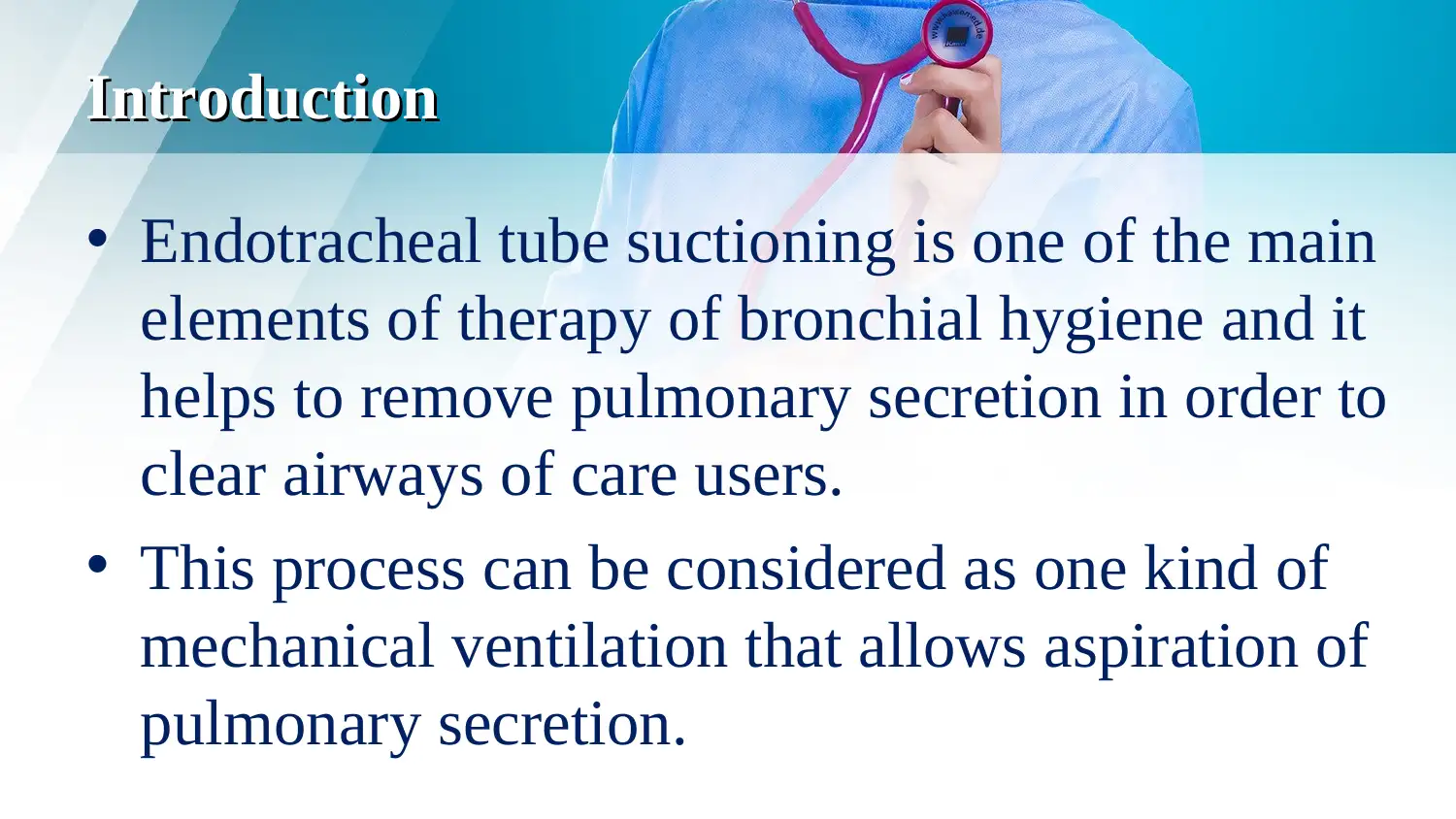
IntroductionIntroduction
• Endotracheal tube suctioning is one of the main
elements of therapy of bronchial hygiene and it
helps to remove pulmonary secretion in order to
clear airways of care users.
• This process can be considered as one kind of
mechanical ventilation that allows aspiration of
pulmonary secretion.
• Endotracheal tube suctioning is one of the main
elements of therapy of bronchial hygiene and it
helps to remove pulmonary secretion in order to
clear airways of care users.
• This process can be considered as one kind of
mechanical ventilation that allows aspiration of
pulmonary secretion.
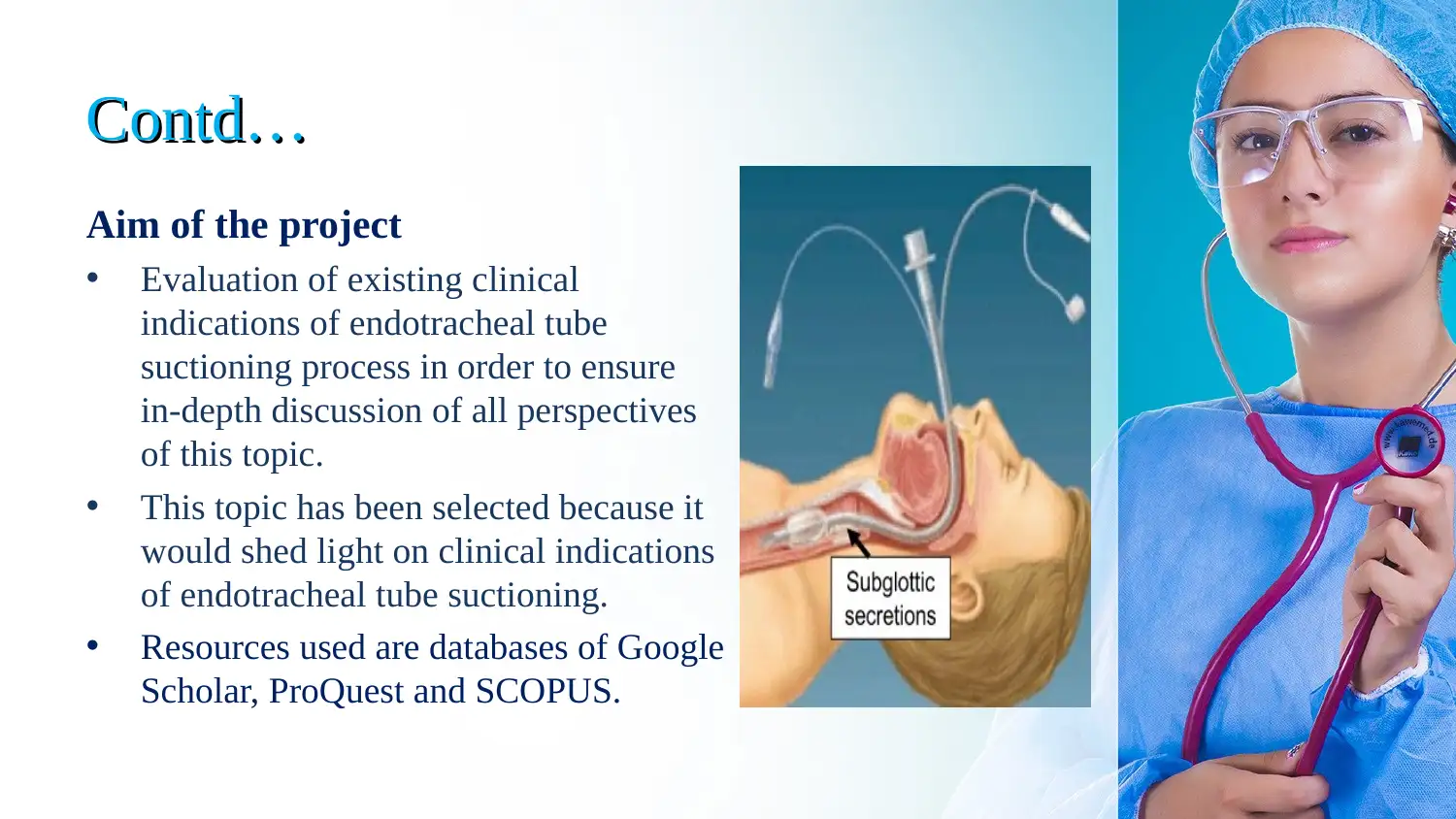
Contd…Contd…
Aim of the project
• Evaluation of existing clinical
indications of endotracheal tube
suctioning process in order to ensure
in-depth discussion of all perspectives
of this topic.
• This topic has been selected because it
would shed light on clinical indications
of endotracheal tube suctioning.
• Resources used are databases of Google
Scholar, ProQuest and SCOPUS.
Aim of the project
• Evaluation of existing clinical
indications of endotracheal tube
suctioning process in order to ensure
in-depth discussion of all perspectives
of this topic.
• This topic has been selected because it
would shed light on clinical indications
of endotracheal tube suctioning.
• Resources used are databases of Google
Scholar, ProQuest and SCOPUS.
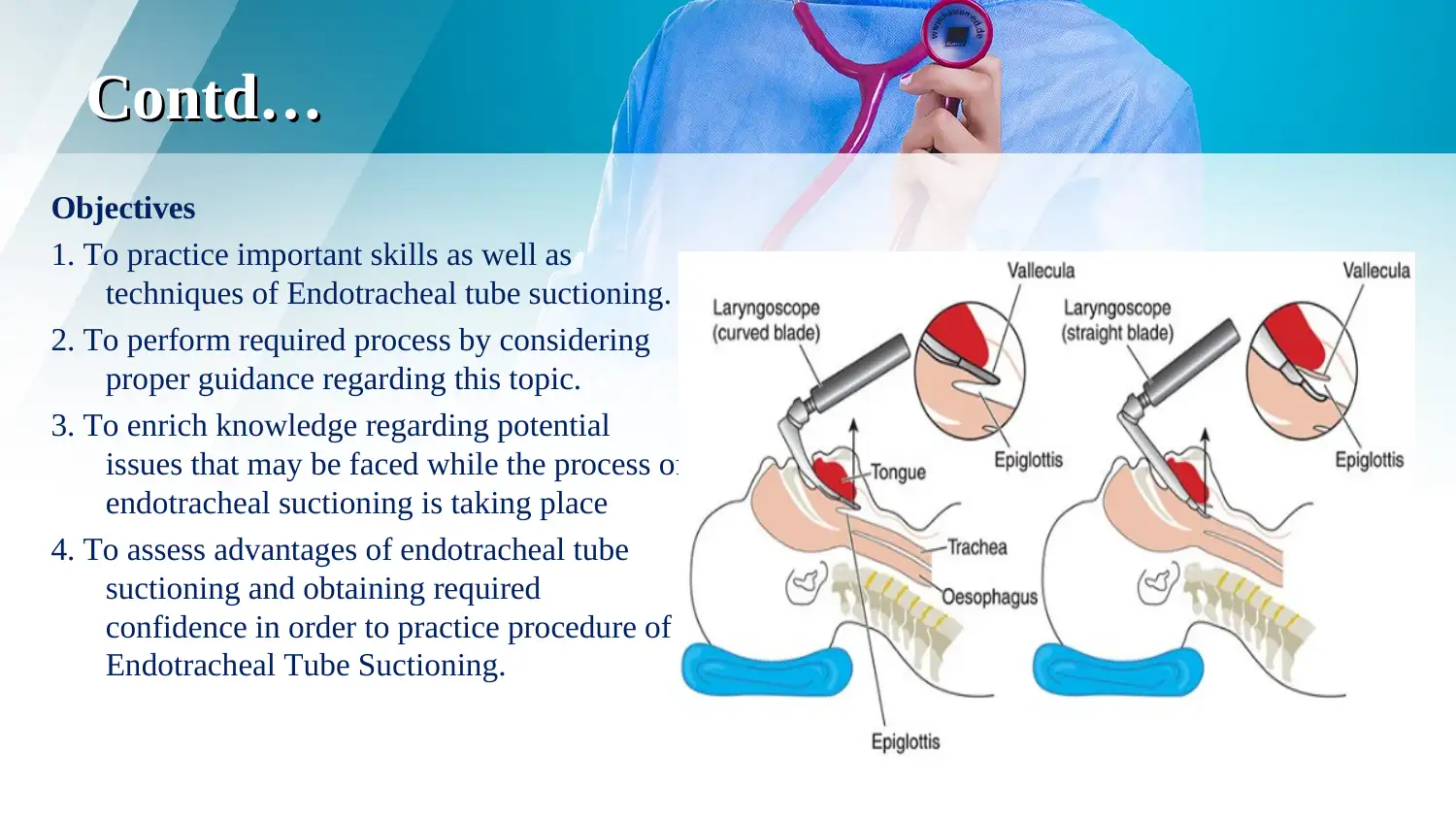
Contd…Contd…
Objectives
1. To practice important skills as well as
techniques of Endotracheal tube suctioning.
2. To perform required process by considering
proper guidance regarding this topic.
3. To enrich knowledge regarding potential
issues that may be faced while the process of
endotracheal suctioning is taking place
4. To assess advantages of endotracheal tube
suctioning and obtaining required
confidence in order to practice procedure of
Endotracheal Tube Suctioning.
Objectives
1. To practice important skills as well as
techniques of Endotracheal tube suctioning.
2. To perform required process by considering
proper guidance regarding this topic.
3. To enrich knowledge regarding potential
issues that may be faced while the process of
endotracheal suctioning is taking place
4. To assess advantages of endotracheal tube
suctioning and obtaining required
confidence in order to practice procedure of
Endotracheal Tube Suctioning.
Secure Best Marks with AI Grader
Need help grading? Try our AI Grader for instant feedback on your assignments.
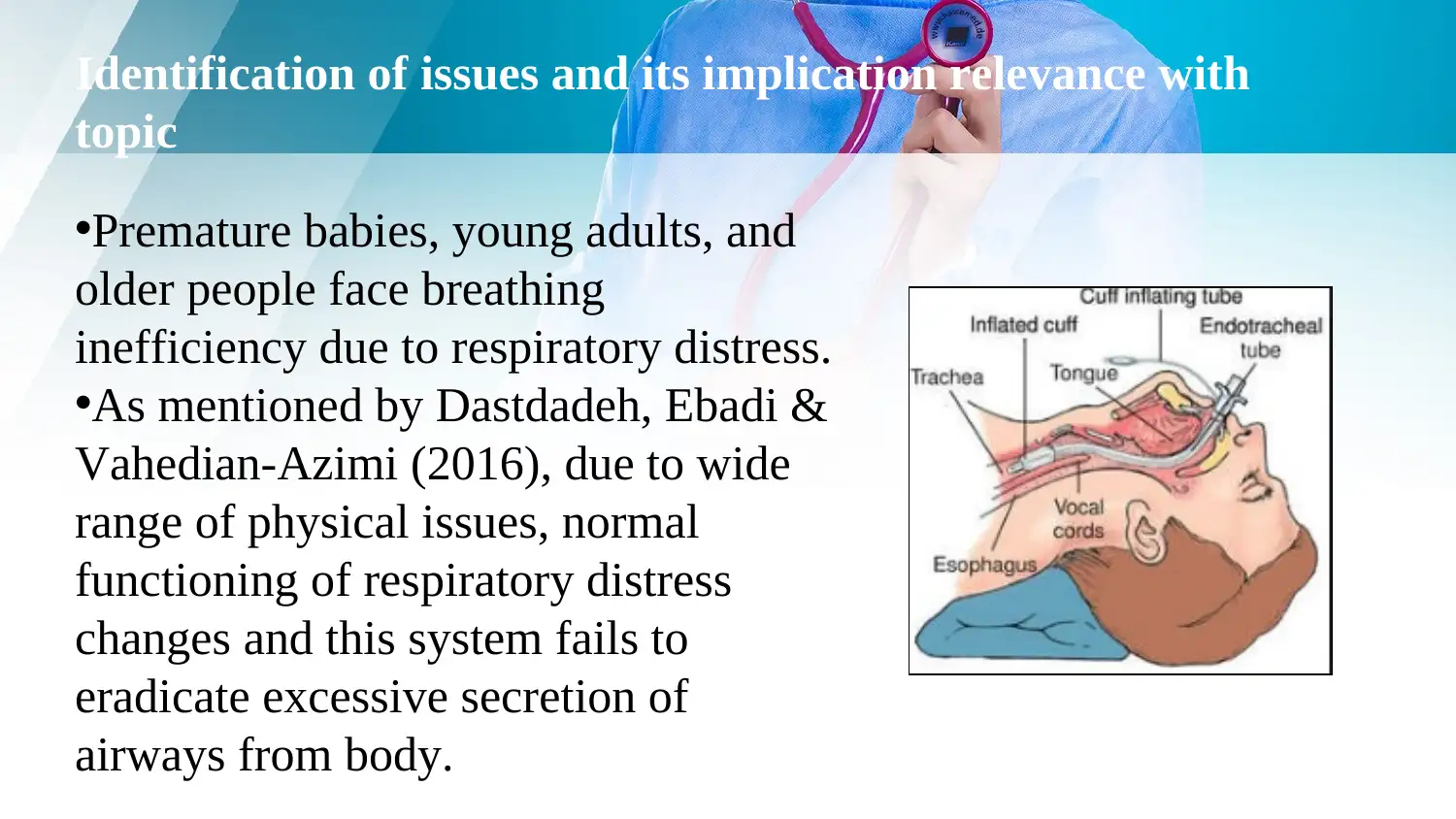
Identification of issues and its implication relevance with
topic
•Premature babies, young adults, and
older people face breathing
inefficiency due to respiratory distress.
•As mentioned by Dastdadeh, Ebadi &
Vahedian-Azimi (2016), due to wide
range of physical issues, normal
functioning of respiratory distress
changes and this system fails to
eradicate excessive secretion of
airways from body.
topic
•Premature babies, young adults, and
older people face breathing
inefficiency due to respiratory distress.
•As mentioned by Dastdadeh, Ebadi &
Vahedian-Azimi (2016), due to wide
range of physical issues, normal
functioning of respiratory distress
changes and this system fails to
eradicate excessive secretion of
airways from body.

Contd…
Issues related to vacuum
pressure while removing
secretion
•As opined by Schults et al.
(2018), endotracheal tube
suction helps to mitigate this
problem by removing
secretion from airways by
mechanical process.
Issues related to vacuum
pressure while removing
secretion
•As opined by Schults et al.
(2018), endotracheal tube
suction helps to mitigate this
problem by removing
secretion from airways by
mechanical process.
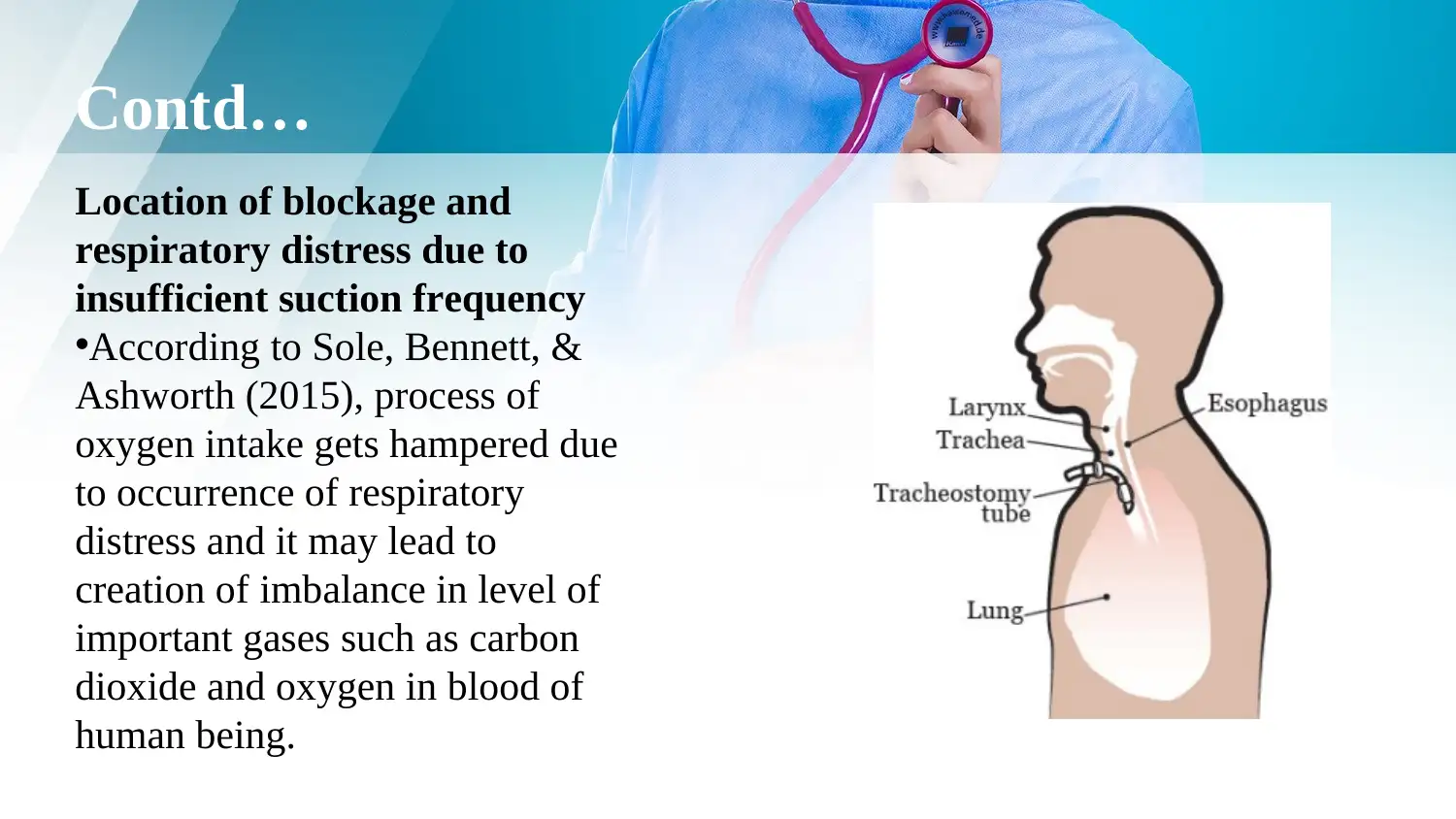
Contd…
Location of blockage and
respiratory distress due to
insufficient suction frequency
•According to Sole, Bennett, &
Ashworth (2015), process of
oxygen intake gets hampered due
to occurrence of respiratory
distress and it may lead to
creation of imbalance in level of
important gases such as carbon
dioxide and oxygen in blood of
human being.
Location of blockage and
respiratory distress due to
insufficient suction frequency
•According to Sole, Bennett, &
Ashworth (2015), process of
oxygen intake gets hampered due
to occurrence of respiratory
distress and it may lead to
creation of imbalance in level of
important gases such as carbon
dioxide and oxygen in blood of
human being.
Paraphrase This Document
Need a fresh take? Get an instant paraphrase of this document with our AI Paraphraser
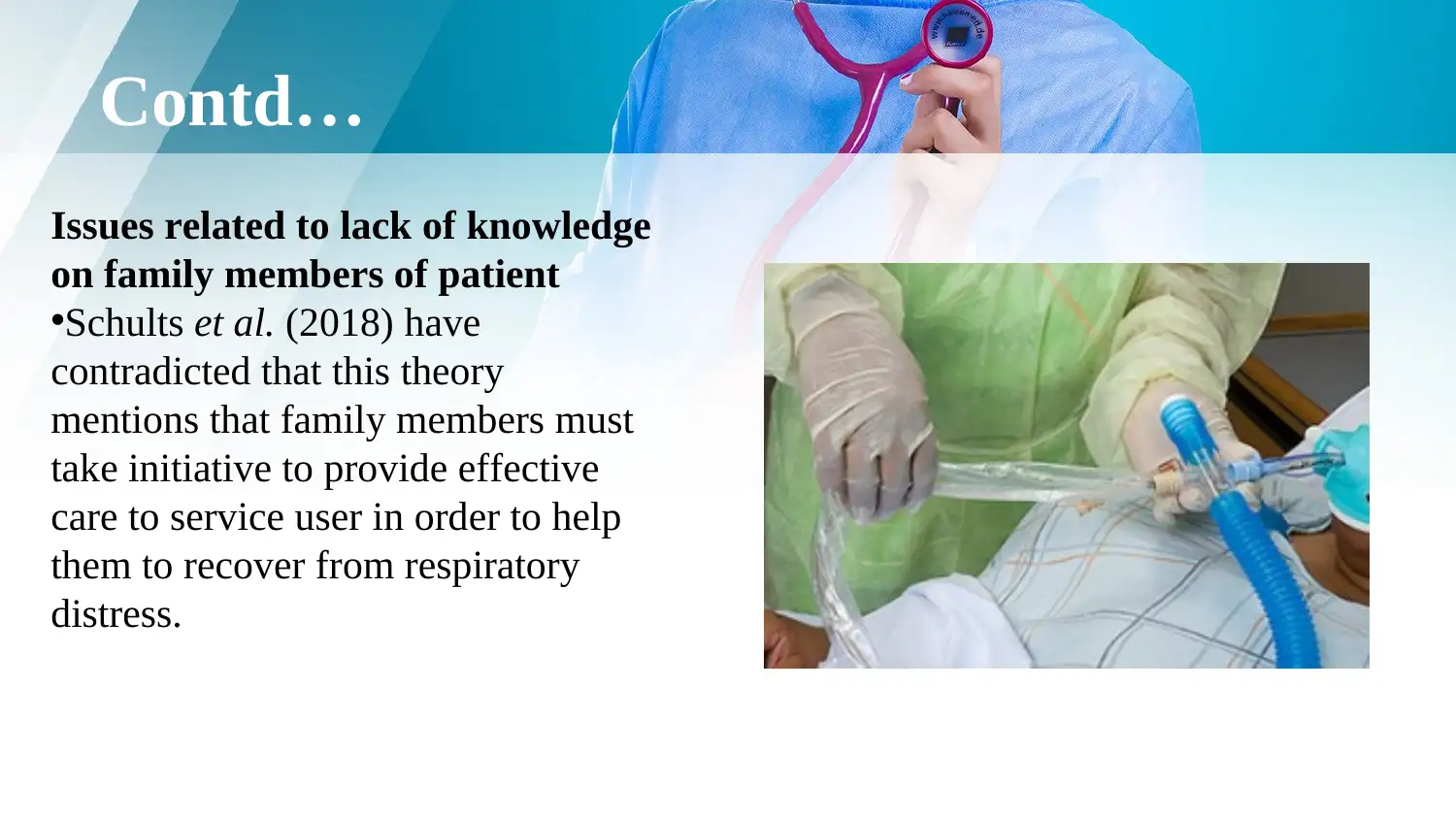
Contd…
Issues related to lack of knowledge
on family members of patient
•Schults et al. (2018) have
contradicted that this theory
mentions that family members must
take initiative to provide effective
care to service user in order to help
them to recover from respiratory
distress.
Issues related to lack of knowledge
on family members of patient
•Schults et al. (2018) have
contradicted that this theory
mentions that family members must
take initiative to provide effective
care to service user in order to help
them to recover from respiratory
distress.
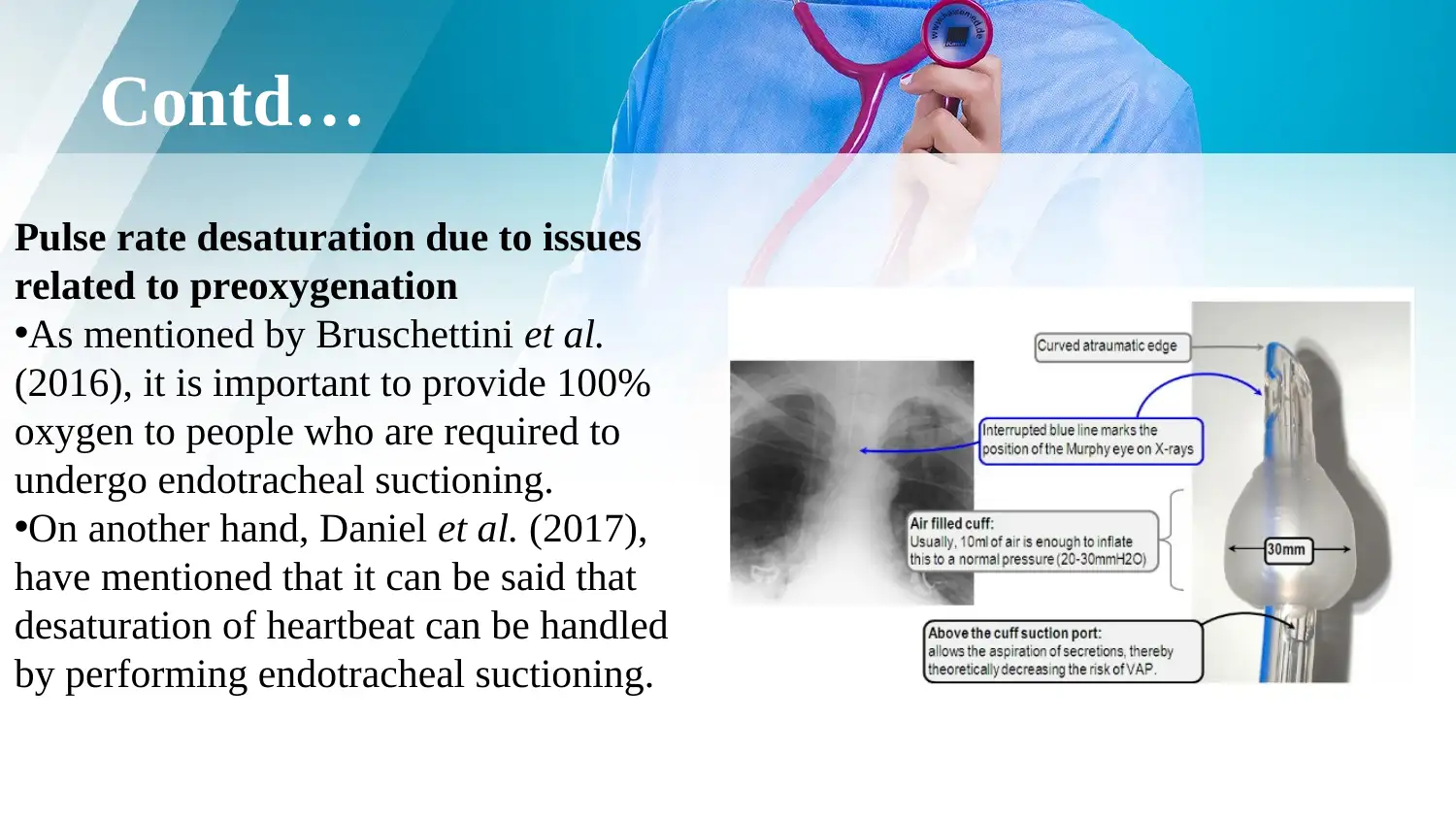
Contd…
Pulse rate desaturation due to issues
related to preoxygenation
•As mentioned by Bruschettini et al.
(2016), it is important to provide 100%
oxygen to people who are required to
undergo endotracheal suctioning.
•On another hand, Daniel et al. (2017),
have mentioned that it can be said that
desaturation of heartbeat can be handled
by performing endotracheal suctioning.
Pulse rate desaturation due to issues
related to preoxygenation
•As mentioned by Bruschettini et al.
(2016), it is important to provide 100%
oxygen to people who are required to
undergo endotracheal suctioning.
•On another hand, Daniel et al. (2017),
have mentioned that it can be said that
desaturation of heartbeat can be handled
by performing endotracheal suctioning.
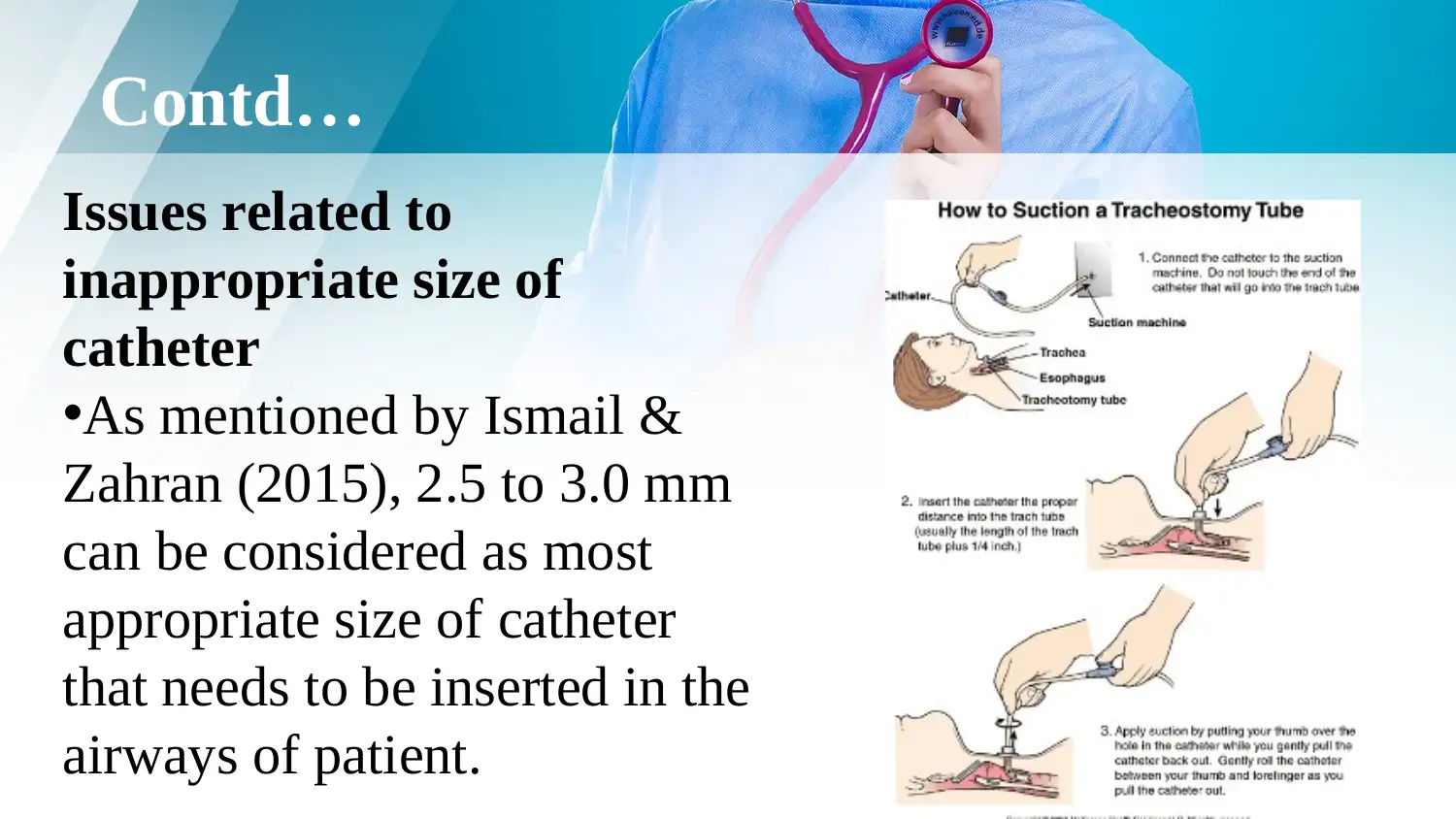
Contd…
Issues related to
inappropriate size of
catheter
•As mentioned by Ismail &
Zahran (2015), 2.5 to 3.0 mm
can be considered as most
appropriate size of catheter
that needs to be inserted in the
airways of patient.
Issues related to
inappropriate size of
catheter
•As mentioned by Ismail &
Zahran (2015), 2.5 to 3.0 mm
can be considered as most
appropriate size of catheter
that needs to be inserted in the
airways of patient.
Secure Best Marks with AI Grader
Need help grading? Try our AI Grader for instant feedback on your assignments.
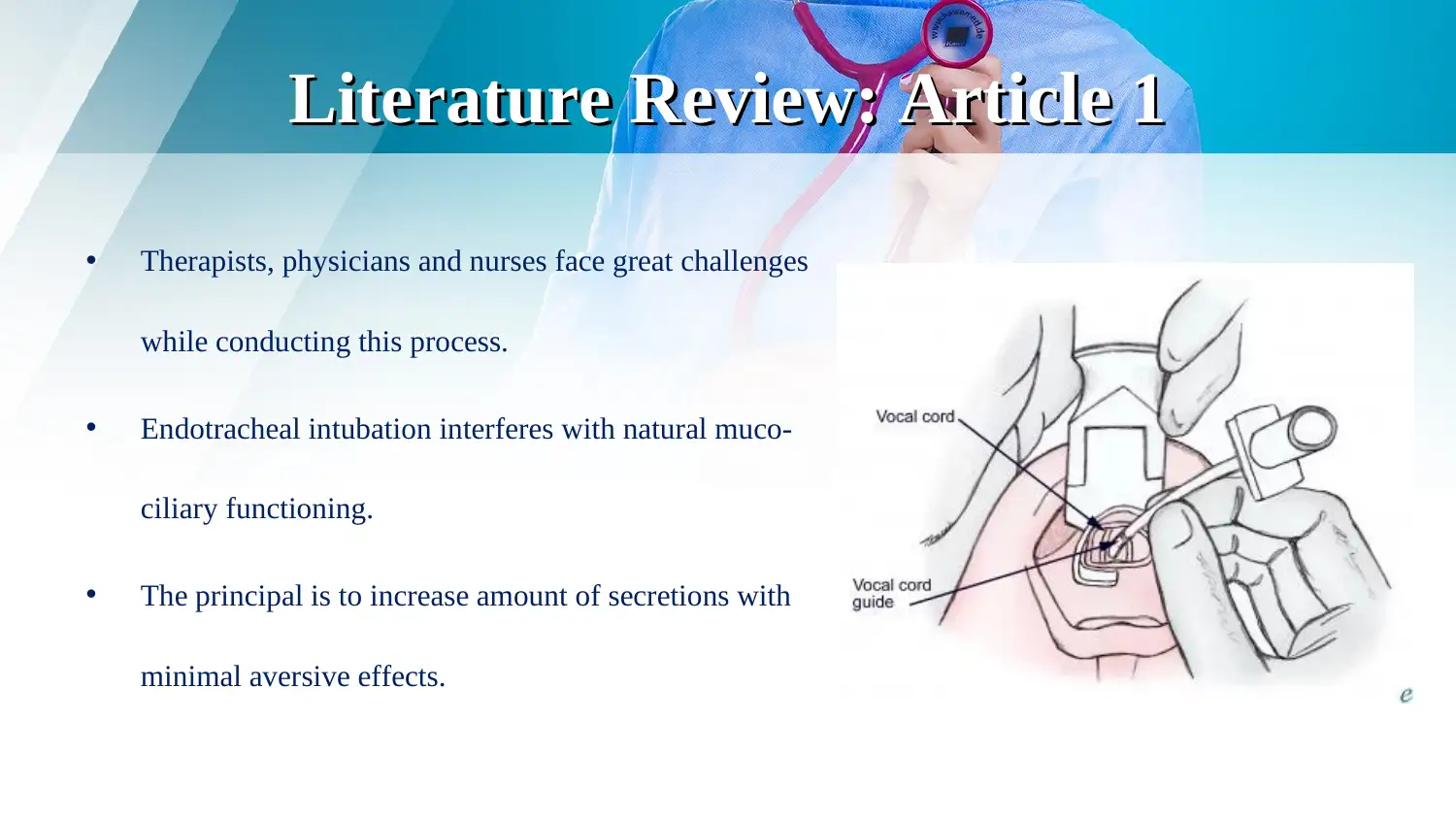
Literature Review: Article 1Literature Review: Article 1
• Therapists, physicians and nurses face great challenges
while conducting this process.
• Endotracheal intubation interferes with natural muco-
ciliary functioning.
• The principal is to increase amount of secretions with
minimal aversive effects.
• Therapists, physicians and nurses face great challenges
while conducting this process.
• Endotracheal intubation interferes with natural muco-
ciliary functioning.
• The principal is to increase amount of secretions with
minimal aversive effects.
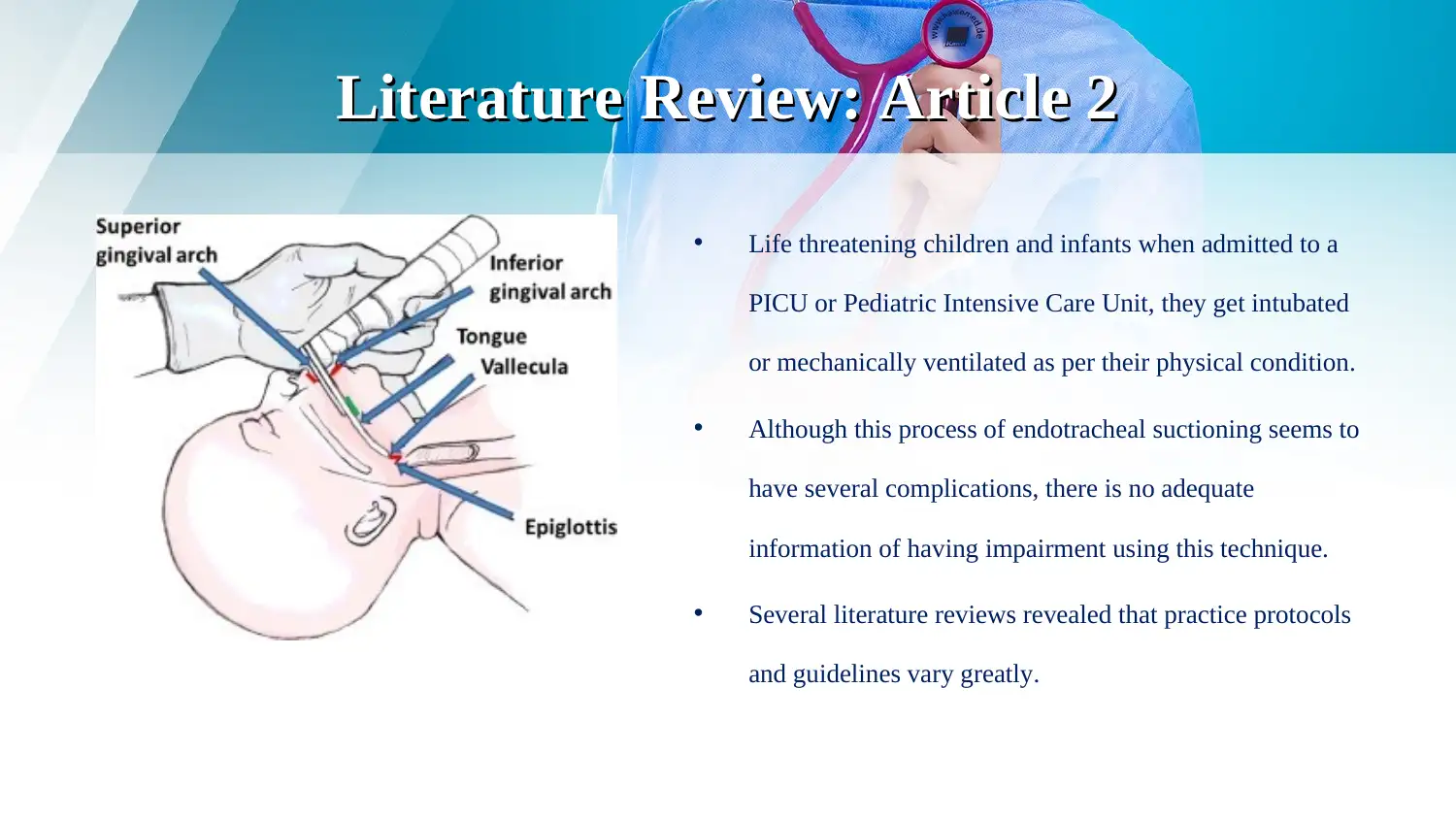
Literature Review: Article 2Literature Review: Article 2
• Life threatening children and infants when admitted to a
PICU or Pediatric Intensive Care Unit, they get intubated
or mechanically ventilated as per their physical condition.
• Although this process of endotracheal suctioning seems to
have several complications, there is no adequate
information of having impairment using this technique.
• Several literature reviews revealed that practice protocols
and guidelines vary greatly.
• Life threatening children and infants when admitted to a
PICU or Pediatric Intensive Care Unit, they get intubated
or mechanically ventilated as per their physical condition.
• Although this process of endotracheal suctioning seems to
have several complications, there is no adequate
information of having impairment using this technique.
• Several literature reviews revealed that practice protocols
and guidelines vary greatly.
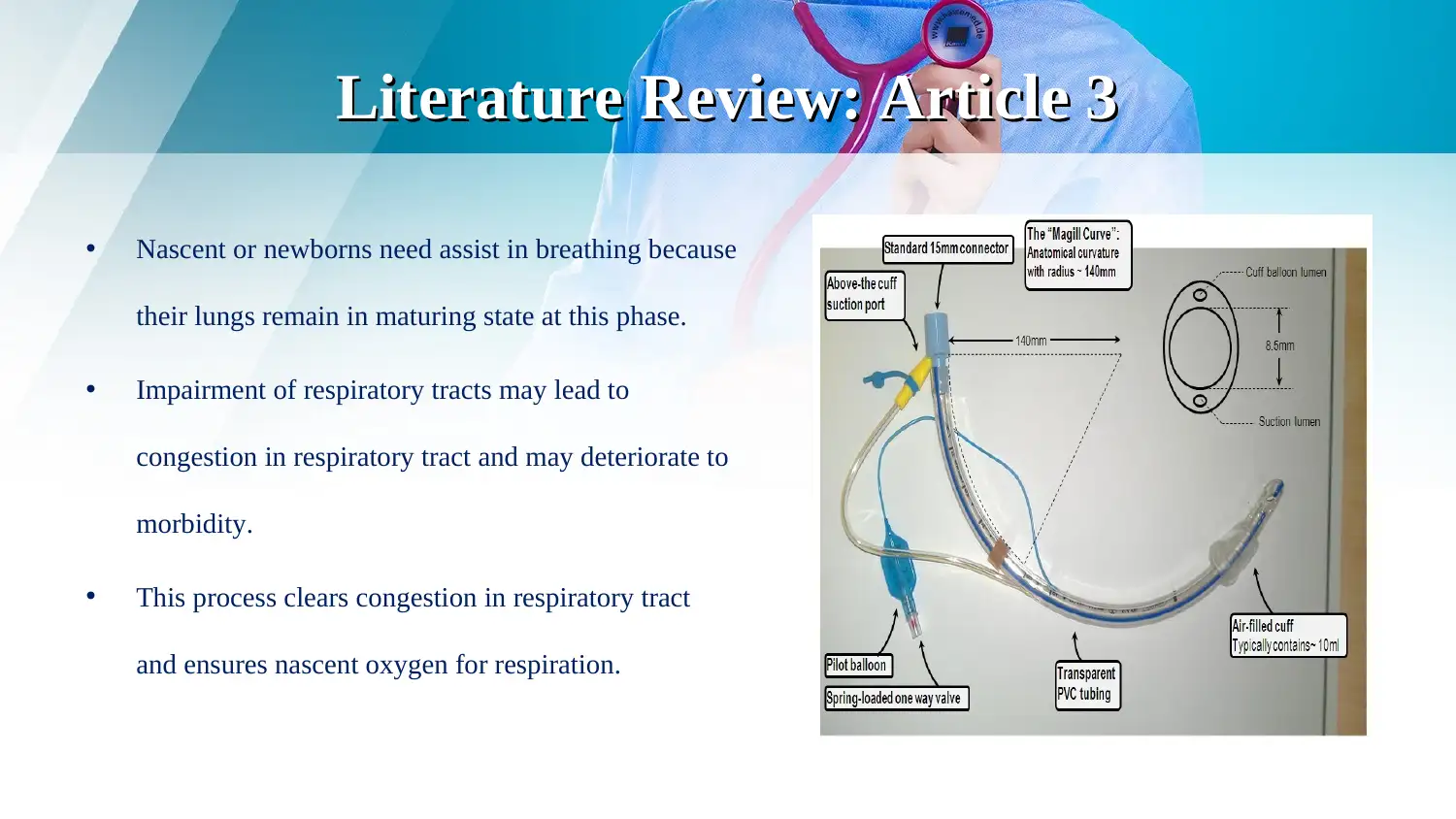
Literature Review: Article 3Literature Review: Article 3
• Nascent or newborns need assist in breathing because
their lungs remain in maturing state at this phase.
• Impairment of respiratory tracts may lead to
congestion in respiratory tract and may deteriorate to
morbidity.
• This process clears congestion in respiratory tract
and ensures nascent oxygen for respiration.
• Nascent or newborns need assist in breathing because
their lungs remain in maturing state at this phase.
• Impairment of respiratory tracts may lead to
congestion in respiratory tract and may deteriorate to
morbidity.
• This process clears congestion in respiratory tract
and ensures nascent oxygen for respiration.
Paraphrase This Document
Need a fresh take? Get an instant paraphrase of this document with our AI Paraphraser

Literature Review: Article 4Literature Review: Article 4
• In various time, suctioning causes
inflammation, swelling, pain and stress of
the windpipe.
• Coughing during mechanical ventilation
and presence of artificial airway is merely
possible or less effective.
• In fatal aversive conditions, arrhythmia or
oxygen desaturation may also occur.
• In various time, suctioning causes
inflammation, swelling, pain and stress of
the windpipe.
• Coughing during mechanical ventilation
and presence of artificial airway is merely
possible or less effective.
• In fatal aversive conditions, arrhythmia or
oxygen desaturation may also occur.
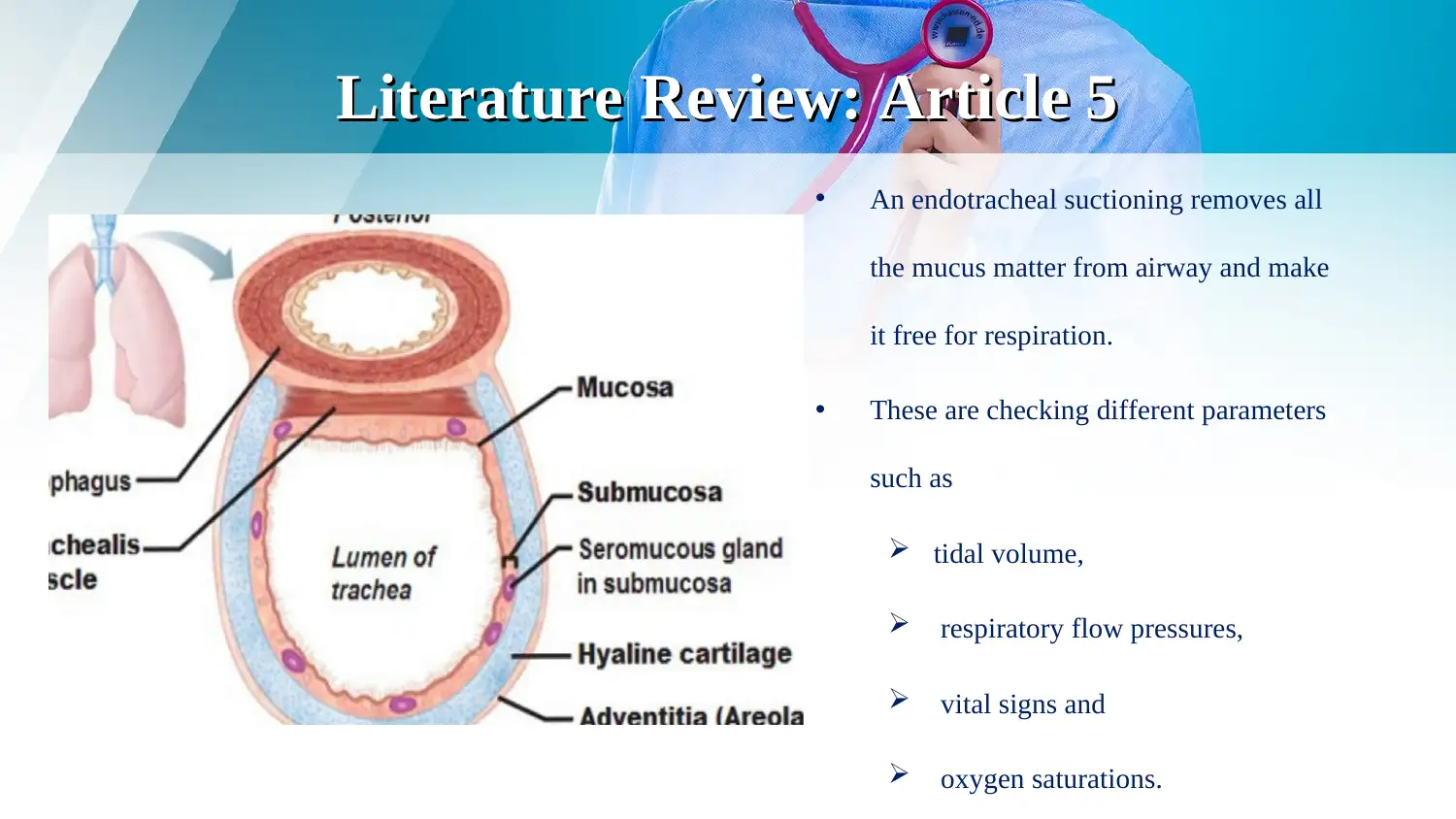
Literature Review: Article 5Literature Review: Article 5
• An endotracheal suctioning removes all
the mucus matter from airway and make
it free for respiration.
• These are checking different parameters
such as
tidal volume,
respiratory flow pressures,
vital signs and
oxygen saturations.
• An endotracheal suctioning removes all
the mucus matter from airway and make
it free for respiration.
• These are checking different parameters
such as
tidal volume,
respiratory flow pressures,
vital signs and
oxygen saturations.
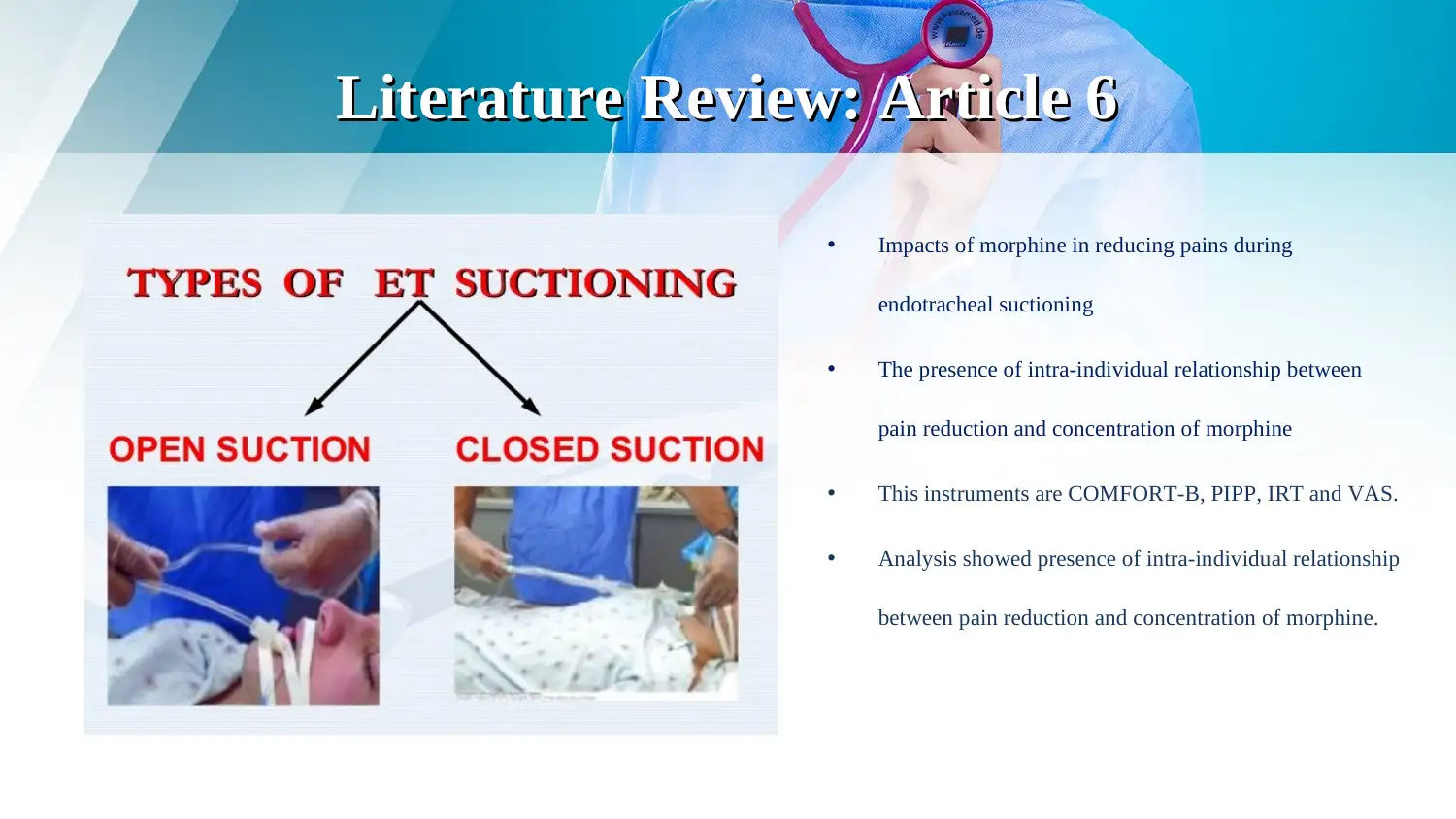
Literature Review: Article 6Literature Review: Article 6
• Impacts of morphine in reducing pains during
endotracheal suctioning
• The presence of intra-individual relationship between
pain reduction and concentration of morphine
• This instruments are COMFORT-B, PIPP, IRT and VAS.
• Analysis showed presence of intra-individual relationship
between pain reduction and concentration of morphine.
• Impacts of morphine in reducing pains during
endotracheal suctioning
• The presence of intra-individual relationship between
pain reduction and concentration of morphine
• This instruments are COMFORT-B, PIPP, IRT and VAS.
• Analysis showed presence of intra-individual relationship
between pain reduction and concentration of morphine.
Secure Best Marks with AI Grader
Need help grading? Try our AI Grader for instant feedback on your assignments.
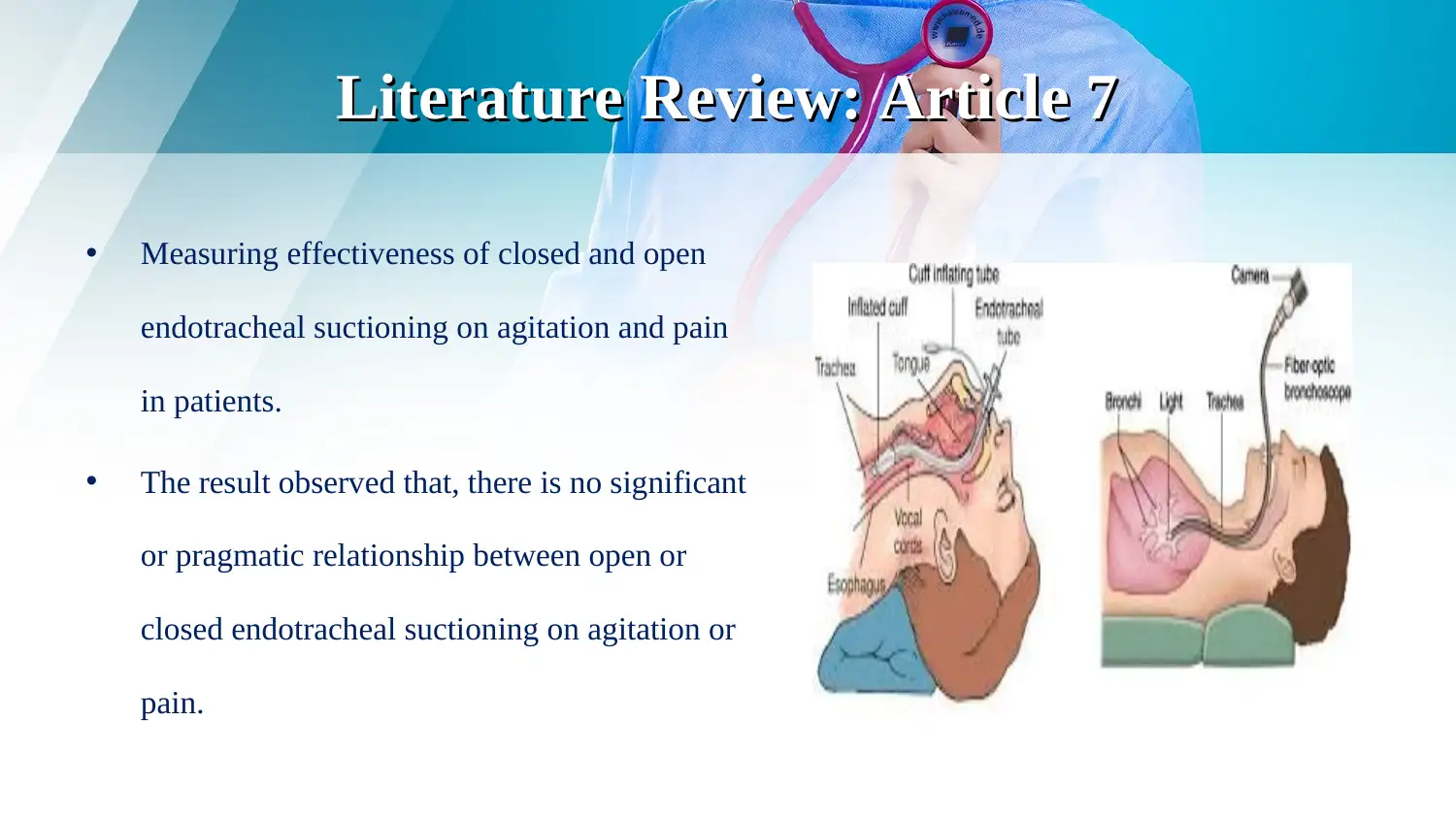
Literature Review: Article 7Literature Review: Article 7
• Measuring effectiveness of closed and open
endotracheal suctioning on agitation and pain
in patients.
• The result observed that, there is no significant
or pragmatic relationship between open or
closed endotracheal suctioning on agitation or
pain.
• Measuring effectiveness of closed and open
endotracheal suctioning on agitation and pain
in patients.
• The result observed that, there is no significant
or pragmatic relationship between open or
closed endotracheal suctioning on agitation or
pain.

Literature Review: Article 8Literature Review: Article 8
• Significant effects of application of lung
recruitment and normal saline installation in
endotracheal suctioning of pediatrics.
• The feasible outcome of this study shows that
this situation of normal saline installation
• Lung recruitment greatly varies with the
mechanical ventilations.
• Significant effects of application of lung
recruitment and normal saline installation in
endotracheal suctioning of pediatrics.
• The feasible outcome of this study shows that
this situation of normal saline installation
• Lung recruitment greatly varies with the
mechanical ventilations.
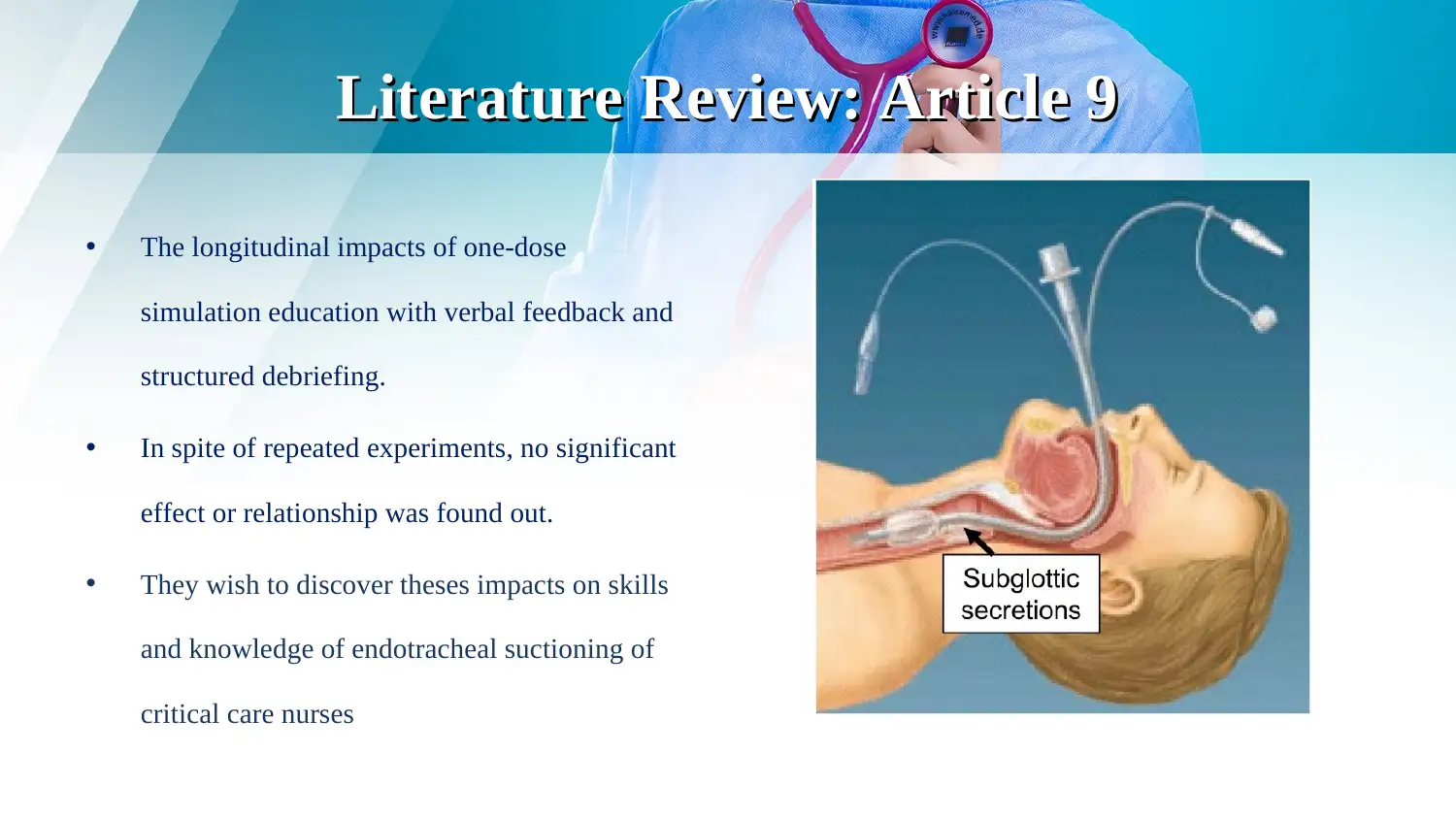
Literature Review: Article 9Literature Review: Article 9
• The longitudinal impacts of one-dose
simulation education with verbal feedback and
structured debriefing.
• In spite of repeated experiments, no significant
effect or relationship was found out.
• They wish to discover theses impacts on skills
and knowledge of endotracheal suctioning of
critical care nurses
• The longitudinal impacts of one-dose
simulation education with verbal feedback and
structured debriefing.
• In spite of repeated experiments, no significant
effect or relationship was found out.
• They wish to discover theses impacts on skills
and knowledge of endotracheal suctioning of
critical care nurses
Paraphrase This Document
Need a fresh take? Get an instant paraphrase of this document with our AI Paraphraser
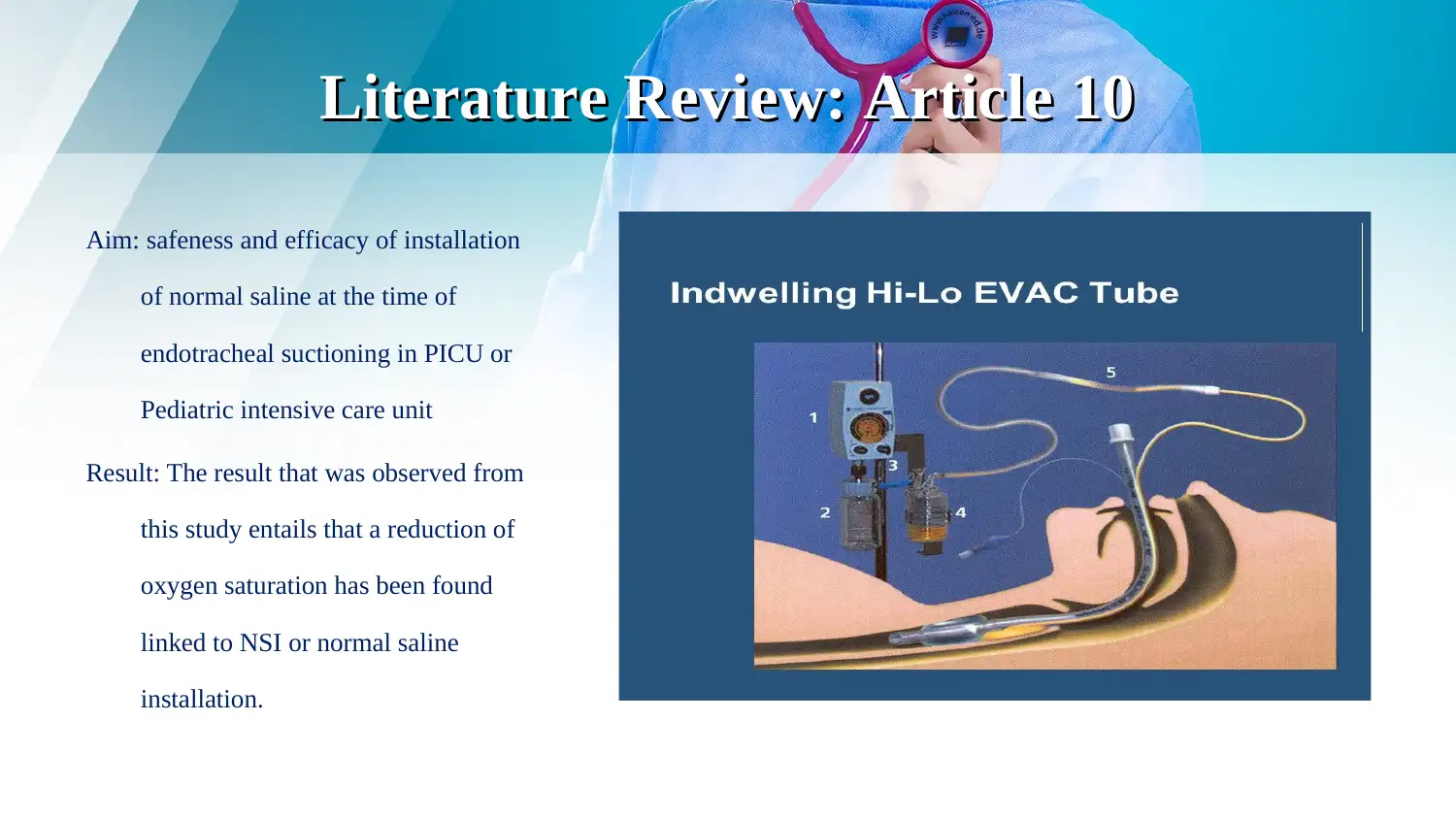
Literature Review: Article 10Literature Review: Article 10
Aim: safeness and efficacy of installation
of normal saline at the time of
endotracheal suctioning in PICU or
Pediatric intensive care unit
Result: The result that was observed from
this study entails that a reduction of
oxygen saturation has been found
linked to NSI or normal saline
installation.
Aim: safeness and efficacy of installation
of normal saline at the time of
endotracheal suctioning in PICU or
Pediatric intensive care unit
Result: The result that was observed from
this study entails that a reduction of
oxygen saturation has been found
linked to NSI or normal saline
installation.
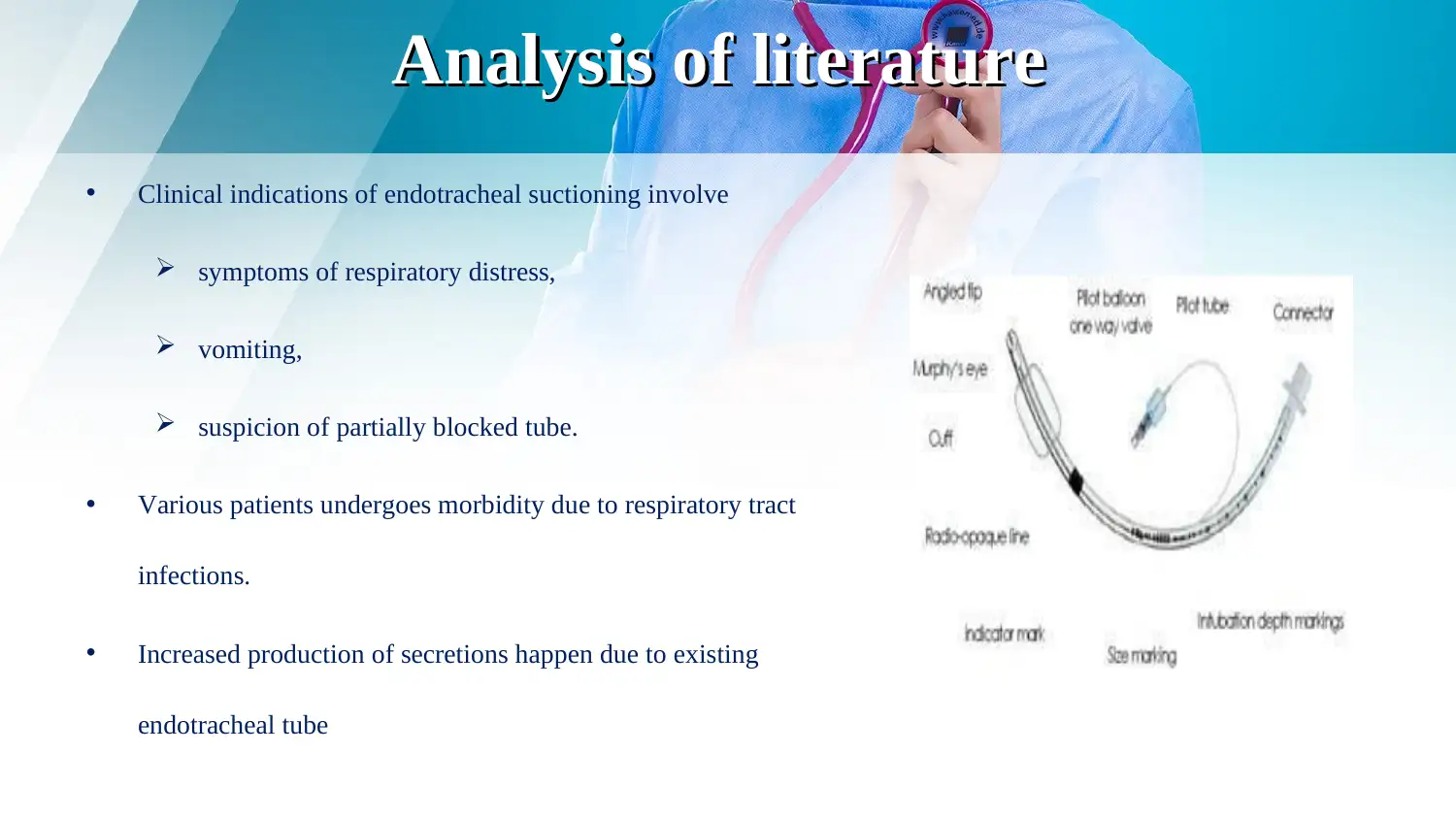
Analysis of literatureAnalysis of literature
• Clinical indications of endotracheal suctioning involve
symptoms of respiratory distress,
vomiting,
suspicion of partially blocked tube.
• Various patients undergoes morbidity due to respiratory tract
infections.
• Increased production of secretions happen due to existing
endotracheal tube
• Clinical indications of endotracheal suctioning involve
symptoms of respiratory distress,
vomiting,
suspicion of partially blocked tube.
• Various patients undergoes morbidity due to respiratory tract
infections.
• Increased production of secretions happen due to existing
endotracheal tube
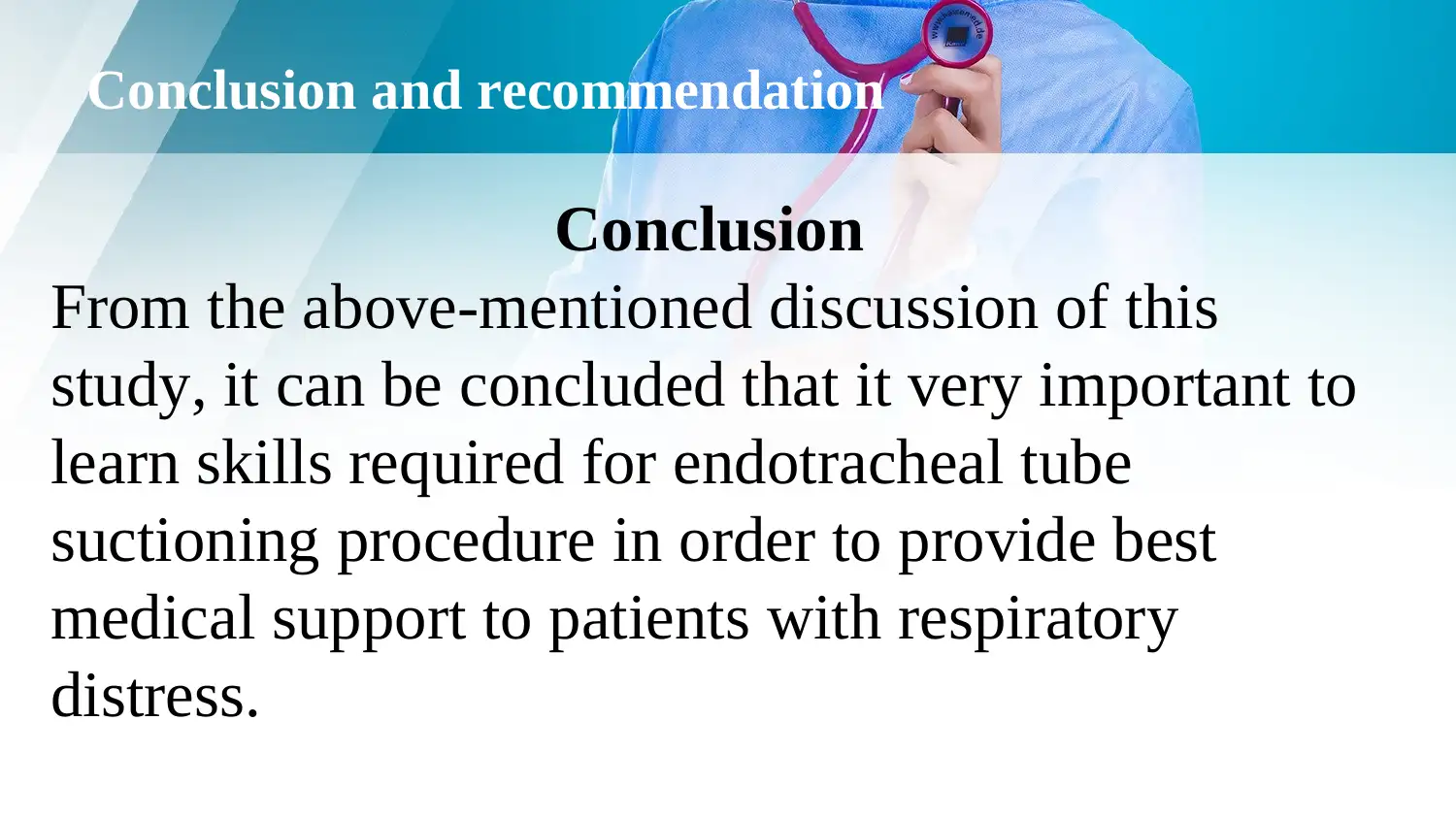
Conclusion and recommendation
Conclusion
From the above-mentioned discussion of this
study, it can be concluded that it very important to
learn skills required for endotracheal tube
suctioning procedure in order to provide best
medical support to patients with respiratory
distress.
Conclusion
From the above-mentioned discussion of this
study, it can be concluded that it very important to
learn skills required for endotracheal tube
suctioning procedure in order to provide best
medical support to patients with respiratory
distress.
Secure Best Marks with AI Grader
Need help grading? Try our AI Grader for instant feedback on your assignments.

Objective linkingObjective linking
• To practice skills of endotracheal tube suctioning: The researcher has undertaken 10 relevant
articles and accumulated significant knowledge from them.
• To perform required process by considering proper guidance: Critical analysis of the literatures
performed primary researches.
• To enrich knowledge regarding potential issues: Literature review quenched the thirst of
knowledge about the issues
• To develop knowledge regarding adverse effects: The aversive effects were identified through
reviewing articles of different researchers.
• To assess advantages of endotracheal tube suctioning: Evaluation of primary studies relevant to
this topic gave distinct idea about the advantages.
• To practice skills of endotracheal tube suctioning: The researcher has undertaken 10 relevant
articles and accumulated significant knowledge from them.
• To perform required process by considering proper guidance: Critical analysis of the literatures
performed primary researches.
• To enrich knowledge regarding potential issues: Literature review quenched the thirst of
knowledge about the issues
• To develop knowledge regarding adverse effects: The aversive effects were identified through
reviewing articles of different researchers.
• To assess advantages of endotracheal tube suctioning: Evaluation of primary studies relevant to
this topic gave distinct idea about the advantages.
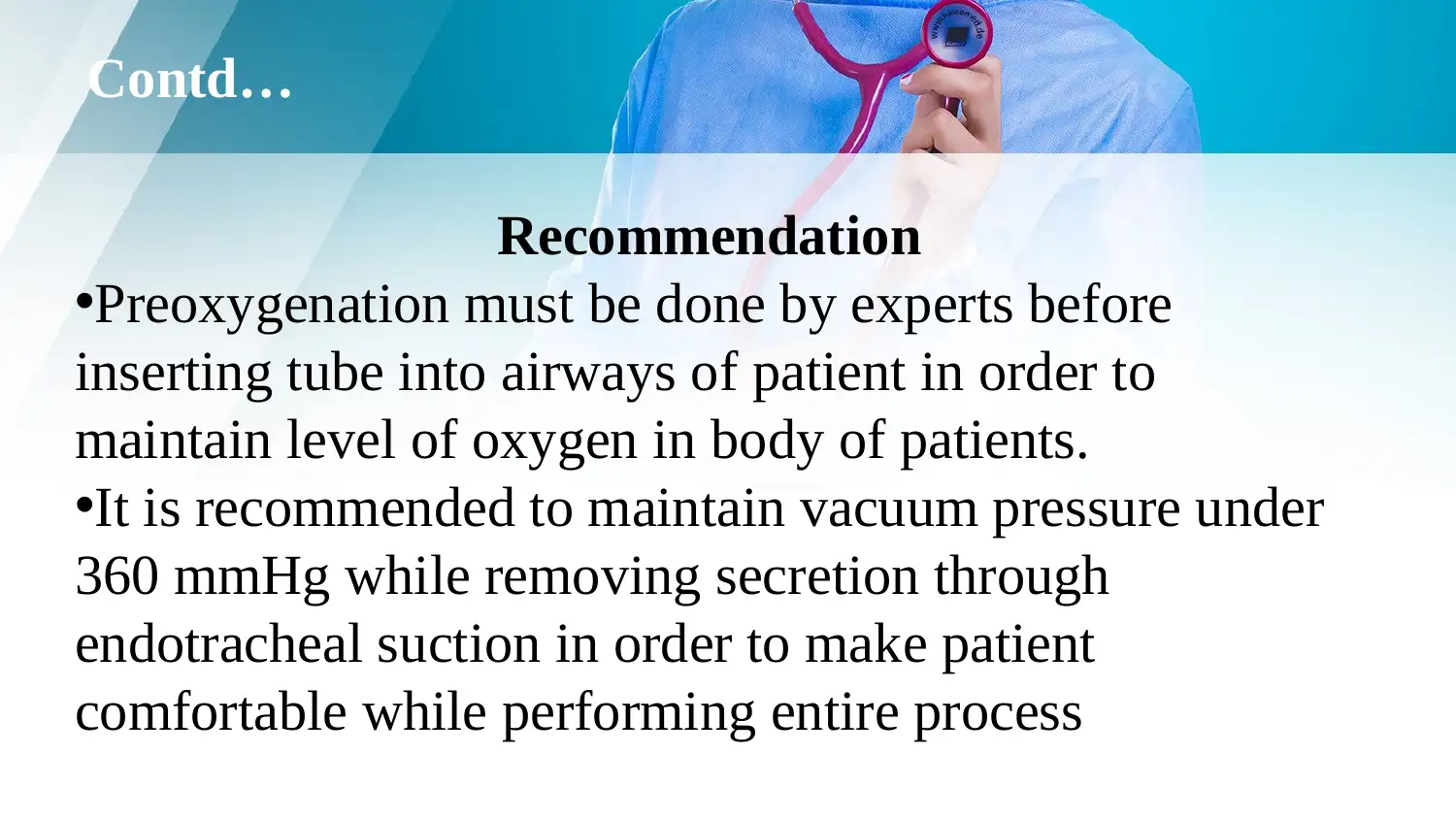
Contd…
Recommendation
•Preoxygenation must be done by experts before
inserting tube into airways of patient in order to
maintain level of oxygen in body of patients.
•It is recommended to maintain vacuum pressure under
360 mmHg while removing secretion through
endotracheal suction in order to make patient
comfortable while performing entire process
Recommendation
•Preoxygenation must be done by experts before
inserting tube into airways of patient in order to
maintain level of oxygen in body of patients.
•It is recommended to maintain vacuum pressure under
360 mmHg while removing secretion through
endotracheal suction in order to make patient
comfortable while performing entire process
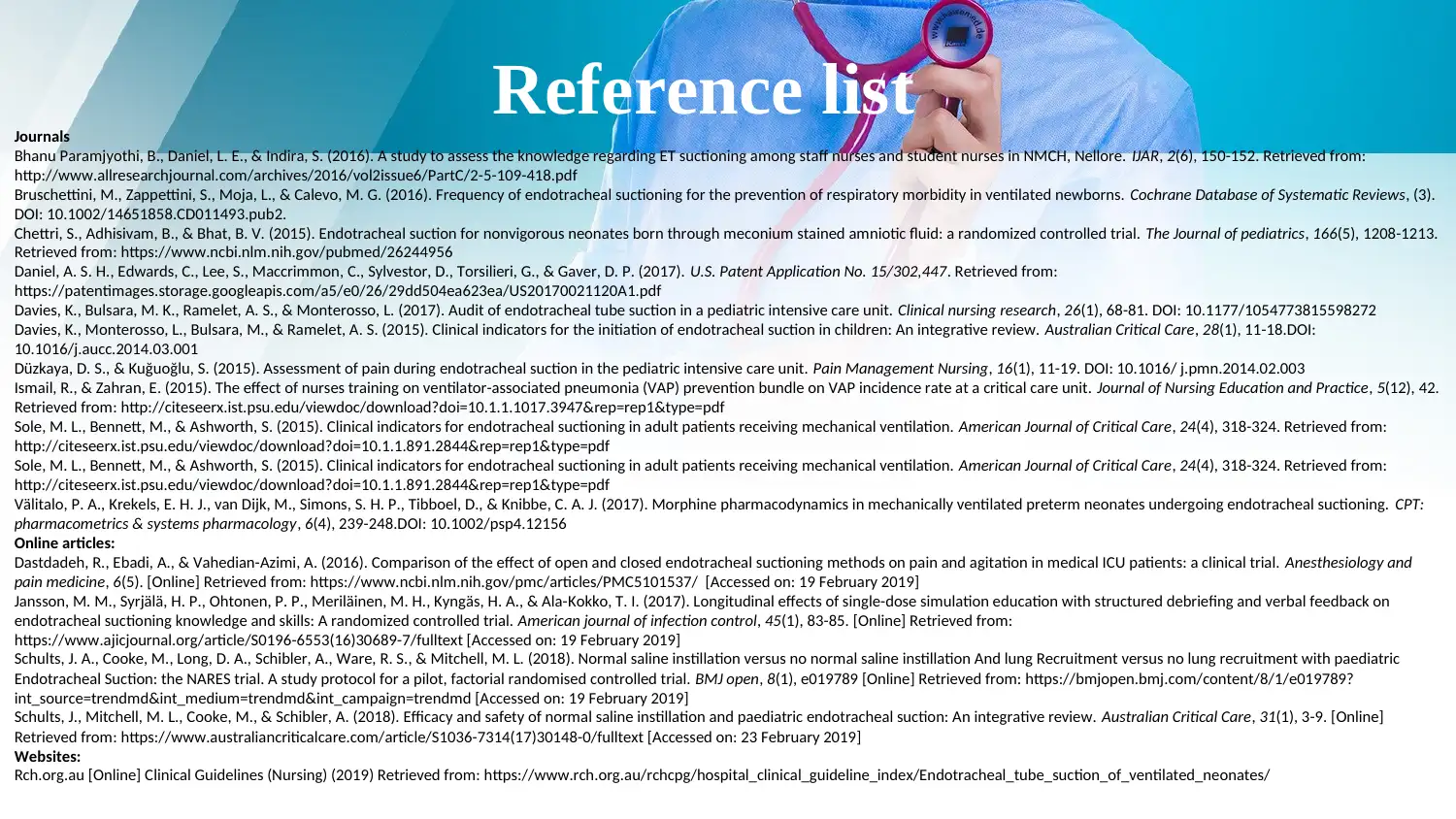
Journals
Bhanu Paramjyothi, B., Daniel, L. E., & Indira, S. (2016). A study to assess the knowledge regarding ET suctioning among staff nurses and student nurses in NMCH, Nellore. IJAR, 2(6), 150-152. Retrieved from:
http://www.allresearchjournal.com/archives/2016/vol2issue6/PartC/2-5-109-418.pdf
Bruschettini, M., Zappettini, S., Moja, L., & Calevo, M. G. (2016). Frequency of endotracheal suctioning for the prevention of respiratory morbidity in ventilated newborns. Cochrane Database of Systematic Reviews, (3).
DOI: 10.1002/14651858.CD011493.pub2.
Chettri, S., Adhisivam, B., & Bhat, B. V. (2015). Endotracheal suction for nonvigorous neonates born through meconium stained amniotic fluid: a randomized controlled trial. The Journal of pediatrics, 166(5), 1208-1213.
Retrieved from: https://www.ncbi.nlm.nih.gov/pubmed/26244956
Daniel, A. S. H., Edwards, C., Lee, S., Maccrimmon, C., Sylvestor, D., Torsilieri, G., & Gaver, D. P. (2017). U.S. Patent Application No. 15/302,447. Retrieved from:
https://patentimages.storage.googleapis.com/a5/e0/26/29dd504ea623ea/US20170021120A1.pdf
Davies, K., Bulsara, M. K., Ramelet, A. S., & Monterosso, L. (2017). Audit of endotracheal tube suction in a pediatric intensive care unit. Clinical nursing research, 26(1), 68-81. DOI: 10.1177/1054773815598272
Davies, K., Monterosso, L., Bulsara, M., & Ramelet, A. S. (2015). Clinical indicators for the initiation of endotracheal suction in children: An integrative review. Australian Critical Care, 28(1), 11-18.DOI:
10.1016/j.aucc.2014.03.001
Düzkaya, D. S., & Kuğuoğlu, S. (2015). Assessment of pain during endotracheal suction in the pediatric intensive care unit. Pain Management Nursing, 16(1), 11-19. DOI: 10.1016/ j.pmn.2014.02.003
Ismail, R., & Zahran, E. (2015). The effect of nurses training on ventilator-associated pneumonia (VAP) prevention bundle on VAP incidence rate at a critical care unit. Journal of Nursing Education and Practice, 5(12), 42.
Retrieved from: http://citeseerx.ist.psu.edu/viewdoc/download?doi=10.1.1.1017.3947&rep=rep1&type=pdf
Sole, M. L., Bennett, M., & Ashworth, S. (2015). Clinical indicators for endotracheal suctioning in adult patients receiving mechanical ventilation. American Journal of Critical Care, 24(4), 318-324. Retrieved from:
http://citeseerx.ist.psu.edu/viewdoc/download?doi=10.1.1.891.2844&rep=rep1&type=pdf
Sole, M. L., Bennett, M., & Ashworth, S. (2015). Clinical indicators for endotracheal suctioning in adult patients receiving mechanical ventilation. American Journal of Critical Care, 24(4), 318-324. Retrieved from:
http://citeseerx.ist.psu.edu/viewdoc/download?doi=10.1.1.891.2844&rep=rep1&type=pdf
Välitalo, P. A., Krekels, E. H. J., van Dijk, M., Simons, S. H. P., Tibboel, D., & Knibbe, C. A. J. (2017). Morphine pharmacodynamics in mechanically ventilated preterm neonates undergoing endotracheal suctioning. CPT:
pharmacometrics & systems pharmacology, 6(4), 239-248.DOI: 10.1002/psp4.12156
Online articles:
Dastdadeh, R., Ebadi, A., & Vahedian-Azimi, A. (2016). Comparison of the effect of open and closed endotracheal suctioning methods on pain and agitation in medical ICU patients: a clinical trial. Anesthesiology and
pain medicine, 6(5). [Online] Retrieved from: https://www.ncbi.nlm.nih.gov/pmc/articles/PMC5101537/ [Accessed on: 19 February 2019]
Jansson, M. M., Syrjälä, H. P., Ohtonen, P. P., Meriläinen, M. H., Kyngäs, H. A., & Ala-Kokko, T. I. (2017). Longitudinal effects of single-dose simulation education with structured debriefing and verbal feedback on
endotracheal suctioning knowledge and skills: A randomized controlled trial. American journal of infection control, 45(1), 83-85. [Online] Retrieved from:
https://www.ajicjournal.org/article/S0196-6553(16)30689-7/fulltext [Accessed on: 19 February 2019]
Schults, J. A., Cooke, M., Long, D. A., Schibler, A., Ware, R. S., & Mitchell, M. L. (2018). Normal saline instillation versus no normal saline instillation And lung Recruitment versus no lung recruitment with paediatric
Endotracheal Suction: the NARES trial. A study protocol for a pilot, factorial randomised controlled trial. BMJ open, 8(1), e019789 [Online] Retrieved from: https://bmjopen.bmj.com/content/8/1/e019789?
int_source=trendmd&int_medium=trendmd&int_campaign=trendmd [Accessed on: 19 February 2019]
Schults, J., Mitchell, M. L., Cooke, M., & Schibler, A. (2018). Efficacy and safety of normal saline instillation and paediatric endotracheal suction: An integrative review. Australian Critical Care, 31(1), 3-9. [Online]
Retrieved from: https://www.australiancriticalcare.com/article/S1036-7314(17)30148-0/fulltext [Accessed on: 23 February 2019]
Websites:
Rch.org.au [Online] Clinical Guidelines (Nursing) (2019) Retrieved from: https://www.rch.org.au/rchcpg/hospital_clinical_guideline_index/Endotracheal_tube_suction_of_ventilated_neonates/
Reference list
Bhanu Paramjyothi, B., Daniel, L. E., & Indira, S. (2016). A study to assess the knowledge regarding ET suctioning among staff nurses and student nurses in NMCH, Nellore. IJAR, 2(6), 150-152. Retrieved from:
http://www.allresearchjournal.com/archives/2016/vol2issue6/PartC/2-5-109-418.pdf
Bruschettini, M., Zappettini, S., Moja, L., & Calevo, M. G. (2016). Frequency of endotracheal suctioning for the prevention of respiratory morbidity in ventilated newborns. Cochrane Database of Systematic Reviews, (3).
DOI: 10.1002/14651858.CD011493.pub2.
Chettri, S., Adhisivam, B., & Bhat, B. V. (2015). Endotracheal suction for nonvigorous neonates born through meconium stained amniotic fluid: a randomized controlled trial. The Journal of pediatrics, 166(5), 1208-1213.
Retrieved from: https://www.ncbi.nlm.nih.gov/pubmed/26244956
Daniel, A. S. H., Edwards, C., Lee, S., Maccrimmon, C., Sylvestor, D., Torsilieri, G., & Gaver, D. P. (2017). U.S. Patent Application No. 15/302,447. Retrieved from:
https://patentimages.storage.googleapis.com/a5/e0/26/29dd504ea623ea/US20170021120A1.pdf
Davies, K., Bulsara, M. K., Ramelet, A. S., & Monterosso, L. (2017). Audit of endotracheal tube suction in a pediatric intensive care unit. Clinical nursing research, 26(1), 68-81. DOI: 10.1177/1054773815598272
Davies, K., Monterosso, L., Bulsara, M., & Ramelet, A. S. (2015). Clinical indicators for the initiation of endotracheal suction in children: An integrative review. Australian Critical Care, 28(1), 11-18.DOI:
10.1016/j.aucc.2014.03.001
Düzkaya, D. S., & Kuğuoğlu, S. (2015). Assessment of pain during endotracheal suction in the pediatric intensive care unit. Pain Management Nursing, 16(1), 11-19. DOI: 10.1016/ j.pmn.2014.02.003
Ismail, R., & Zahran, E. (2015). The effect of nurses training on ventilator-associated pneumonia (VAP) prevention bundle on VAP incidence rate at a critical care unit. Journal of Nursing Education and Practice, 5(12), 42.
Retrieved from: http://citeseerx.ist.psu.edu/viewdoc/download?doi=10.1.1.1017.3947&rep=rep1&type=pdf
Sole, M. L., Bennett, M., & Ashworth, S. (2015). Clinical indicators for endotracheal suctioning in adult patients receiving mechanical ventilation. American Journal of Critical Care, 24(4), 318-324. Retrieved from:
http://citeseerx.ist.psu.edu/viewdoc/download?doi=10.1.1.891.2844&rep=rep1&type=pdf
Sole, M. L., Bennett, M., & Ashworth, S. (2015). Clinical indicators for endotracheal suctioning in adult patients receiving mechanical ventilation. American Journal of Critical Care, 24(4), 318-324. Retrieved from:
http://citeseerx.ist.psu.edu/viewdoc/download?doi=10.1.1.891.2844&rep=rep1&type=pdf
Välitalo, P. A., Krekels, E. H. J., van Dijk, M., Simons, S. H. P., Tibboel, D., & Knibbe, C. A. J. (2017). Morphine pharmacodynamics in mechanically ventilated preterm neonates undergoing endotracheal suctioning. CPT:
pharmacometrics & systems pharmacology, 6(4), 239-248.DOI: 10.1002/psp4.12156
Online articles:
Dastdadeh, R., Ebadi, A., & Vahedian-Azimi, A. (2016). Comparison of the effect of open and closed endotracheal suctioning methods on pain and agitation in medical ICU patients: a clinical trial. Anesthesiology and
pain medicine, 6(5). [Online] Retrieved from: https://www.ncbi.nlm.nih.gov/pmc/articles/PMC5101537/ [Accessed on: 19 February 2019]
Jansson, M. M., Syrjälä, H. P., Ohtonen, P. P., Meriläinen, M. H., Kyngäs, H. A., & Ala-Kokko, T. I. (2017). Longitudinal effects of single-dose simulation education with structured debriefing and verbal feedback on
endotracheal suctioning knowledge and skills: A randomized controlled trial. American journal of infection control, 45(1), 83-85. [Online] Retrieved from:
https://www.ajicjournal.org/article/S0196-6553(16)30689-7/fulltext [Accessed on: 19 February 2019]
Schults, J. A., Cooke, M., Long, D. A., Schibler, A., Ware, R. S., & Mitchell, M. L. (2018). Normal saline instillation versus no normal saline instillation And lung Recruitment versus no lung recruitment with paediatric
Endotracheal Suction: the NARES trial. A study protocol for a pilot, factorial randomised controlled trial. BMJ open, 8(1), e019789 [Online] Retrieved from: https://bmjopen.bmj.com/content/8/1/e019789?
int_source=trendmd&int_medium=trendmd&int_campaign=trendmd [Accessed on: 19 February 2019]
Schults, J., Mitchell, M. L., Cooke, M., & Schibler, A. (2018). Efficacy and safety of normal saline instillation and paediatric endotracheal suction: An integrative review. Australian Critical Care, 31(1), 3-9. [Online]
Retrieved from: https://www.australiancriticalcare.com/article/S1036-7314(17)30148-0/fulltext [Accessed on: 23 February 2019]
Websites:
Rch.org.au [Online] Clinical Guidelines (Nursing) (2019) Retrieved from: https://www.rch.org.au/rchcpg/hospital_clinical_guideline_index/Endotracheal_tube_suction_of_ventilated_neonates/
Reference list
Paraphrase This Document
Need a fresh take? Get an instant paraphrase of this document with our AI Paraphraser

1 out of 26
Related Documents
Your All-in-One AI-Powered Toolkit for Academic Success.
+13062052269
info@desklib.com
Available 24*7 on WhatsApp / Email
![[object Object]](/_next/static/media/star-bottom.7253800d.svg)
Unlock your academic potential
© 2024 | Zucol Services PVT LTD | All rights reserved.





